Exploring Optimal Cropping System to Improve the Water Use Efficiency and Soil Water Restoration after Lucerne-to-Crop Conversion in the Semiarid Environment
Abstract
:1. Introduction
2. Materials and Methods
2.1. Description of the Study Site
2.2. Experimental Design and Field Management
2.3. Measurements and Data Analysis
2.4. Statistical Analyses
3. Results
3.1. Weather Conditions
3.2. Soil Properties
3.3. Soil Water Recovery
3.4. Net Economic Return
4. Discussion
5. Conclusions
Author Contributions
Funding
Institutional Review Board Statement
Informed Consent Statement
Data Availability Statement
Acknowledgments
Conflicts of Interest
References
- Peng, Z.; Wang, L.; Xie, J.; Li, L.; Coulter, J.A.; Zhang, R.; Luo, Z.; Cai, L.; Carberry, P.; Whitbread, A. Conservation tillage increases yield and precipitation use efficiency of wheat on the semi-arid Loess Plateau of China. Agric. Water Manag. 2020, 231, 106024. [Google Scholar] [CrossRef]
- Wang, L.; Palta, J.; Chen, W.; Chen, Y.; Deng, X. Nitrogen fertilization improved water-use efficiency of winter wheat through increasing water use during vegetative rather than grain filling. Agric. Water Manag. 2018, 197, 41–53. [Google Scholar] [CrossRef]
- Deng, X.; Shan, L.; Zhang, H.; Turner, N.C. Improving agricultural water use efficiency in arid and semiarid areas of China. Agric. Water Manag. 2006, 80, 23–40. [Google Scholar] [CrossRef]
- Yang, X.; Li, P.; Zhang, S.; Sun, B.; Xinping, C. Long-term-fertilization effects on soil organic carbon, physical properties, and wheat yield of a loess soil. J. Plant Nutr. Soil Sci. 2011, 174, 775–784. [Google Scholar] [CrossRef]
- Li, F.M.; Li, X.G.; Javaid, M.M.; Ashraf, M.; Zhang, F. Ridge-furrow plastic film mulching farming for sustainable dryland agriculture on the Chinese loess plateau. Agron. J. 2020, 112, 3284–3294. [Google Scholar] [CrossRef]
- Jun, F.; Mingan, S.; QuanJiu, W.; Jones, S.B.; Reichardt, K.; Xiangrong, C.; Xiaoli, F. Toward sustainable soil and water resources use in China’s highly erodible semi-arid loess plateau. Geoderma 2010, 155, 93–100. [Google Scholar] [CrossRef]
- Jia, Y.; Li, F.; Wang, X. Soil quality responses to alfalfa watered with a field micro-catchment technique in the Loess Plateau of China. Field Crops Res. 2006, 95, 64–74. [Google Scholar] [CrossRef]
- Li, Y. Productivity dynamic of alfalfa and its effects on water eco-environment. Acta Pedol. Sin. 2002, 39, 404–411, (In Chinese with English abstract). [Google Scholar]
- Wang, L.; Xie, J.; Luo, Z.; Niu, Y.; Coulter, J.A.; Zhang, R.; Lingling, L. Forage yield, water use efficiency, and soil fertility response to alfalfa growing age in the semiarid Loess Plateau of China. Agric. Water Manag. 2021, 243, 106415. [Google Scholar] [CrossRef]
- Li, Y.; Huang, M. Pasture yield and soil water depletion of continuous growing alfalfa in the Loess Plateau of China. Agric. Ecosyst. Environ. 2008, 124, 24–32. [Google Scholar] [CrossRef]
- Crawford, M.; Macfarlane, M. Lucerne reduces soil moisture and increases livestock production in an area of high groundwater recharge potential. Aust. J. Exp. Agric. 1995, 35, 171–180. [Google Scholar] [CrossRef]
- Ren, J.; Li, J.; Wang, X.; Fang, X. Soil water and nutrient characteristics of alfalfa grasslands at semi-arid and semi-arid prone to drought areas in southern Ningxia. Acta Ecol. Sin. 2011, 31, 3638–3649. [Google Scholar]
- Latta, R.A.; Blacklow, L.J.; Cocks, P.S. Comparative soil water, pasture production, and crop yields in phase farming systems with lucerne and annual pasture in Western Australia. Aust. J. Agric. Res. 2001, 52, 295–303. [Google Scholar] [CrossRef]
- Ridley, A.M.; Christy, B.; Dunin, F.X.; Haines, P.J.; Wilson, K.F.; Ellington, A. Lucerne in crop rotations on the Riverine Plains. 1. The soil water balance. Aust. J. Agric. Res. 2001, 52, 263–277. [Google Scholar] [CrossRef]
- Wang, X.C.; Li, J.; Tahir, M.N.; Fang, X.Y. Validation of the EPIC model and its utilization to research the sustainable recovery of soil desiccation after alfalfa (Medicago sativa L.) by grain crop rotation system in the semi-humid region of the Loess Plateau. Agric. Ecosyst. Environ. 2012, 161, 152–160. [Google Scholar] [CrossRef]
- Jackson, T.; Halvorson, A.; Tucker, B.; Dregne, H.; Willis, W. Soil fertility in dryland agriculture. In Dryland Agriculture; Agron No. 23; American Society Agronomy: Madison, WI, USA, 1983; pp. 297–332. [Google Scholar]
- Cantero-Martinez, C.; O’Leary, G.J.; Connor, D.J. Stubble retention and nitrogen fertilisation in a fallow-wheat rainfed cropping system. 1. Soil water and nitrogen conservation, crop growth and yield. Soil Tillage Res. 1995, 34, 79–94. [Google Scholar] [CrossRef]
- Wang, X.; Sun, G.; Jia, Y.; Li, F.; Xu, J. Crop yield and soil water restoration on 9-year-old alfalfa pasture in the semiarid Loess Plateau of China. Agric. Water Manag. 2008, 95, 190–198. [Google Scholar] [CrossRef]
- Jia, Y.; Li, F.M.; Zhang, Z.H.; Wang, X.L.; Guo, R.; Siddique, K.H.M. Productivity and water use of alfalfa and subsequent crops in the semiarid Loess Plateau with different stand ages of alfalfa and crop sequences. Field Crops Res. 2009, 114, 58–65. [Google Scholar] [CrossRef]
- Niu, Y.; Zhang, R.; Luo, Z.; Li, L.; Cai, L.; Li, G.; Xie, J. Contributions of long-term tillage systems on crop production and soil properties in the semi-arid Loess Plateau of China. J. Sci. Food Agric. 2016, 96, 2650–2659. [Google Scholar] [CrossRef]
- Xie, J.; Wang, L.; Li, L.; Coulter, J.A.; Chai, Q.; Zhang, R.; Luo, Z.; Carberry, P.; Rao, K. Subsoiling increases grain yield, water use efficiency, and economic return of maize under a fully mulched ridge-furrow system in a semiarid environment in China. Soil Tillage Res. 2020, 199, 104584. [Google Scholar] [CrossRef]
- Liu, H.; Wang, Z.; Yu, R.; Li, F.; Li, K.; Cao, H.; Yang, N.; Li, M.; Dai, J.; Zan, Y.; et al. Optimal nitrogen input for higher efficiency and lower environmental impacts of winter wheat production in China. Agric. Ecosyst. Environ. 2016, 224, 1–11. [Google Scholar] [CrossRef]
- Sun, T.; Li, Z. Alfalfa-corn rotation and row placement affects yield, water use, and economic returns in Northeast China. Field Crops Res. 2019, 241, 107558. [Google Scholar] [CrossRef]
- Wang, L.; Coulter, J.A.; Li, L.; Luo, Z.; Xie, J. Plastic mulching reduces nitrogen footprint of food crops in China: A meta-analysis. Sci. Total Environ. 2020, 748, 141479. [Google Scholar] [CrossRef]
- Zhang, C.; Wang, Y.; Jia, X.; Shao Ma An, Z. Variations in capacity and storage of plant-available water in deep profiles along a revegetation and precipitation gradient. J. Hydrol. 2020, 581, 124401. [Google Scholar] [CrossRef]
- Yu, B.; Xie, C.; Cai, S.; Chen, Y.; Lv, Y.; Mo, Z.; Liu, T.; Yang, Z. Effects of Tree Root Density on Soil Total Porosity and Non-Capillary Porosity Using a Ground-Penetrating Tree Radar Unit in Shanghai, China. Sustainability 2018, 10, 4640. [Google Scholar] [CrossRef]
- Zhang, R. Determination of Soil Sorptivity and Hydraulic Conductivity from the Disk Infiltrometer. Soil Sci. Soc. Am. J. 1997, 61, 1024–1030. [Google Scholar] [CrossRef]
- Wang, L.; Luo, Z.; Li, L.; Xie, J.; Fudjoe, S.K.; Zechariah, E. Land Use Affects Soil Water Balance and Soil Desiccation within the Soil Profile, Evidence from the Western Loess Plateau Case. Land 2022, 11, 1136. [Google Scholar] [CrossRef]
- Xie, J.H.; Chai, Q.; Zhang, R.Z.; Luo, Z.Z.; Li, L.L.; Niu, Y.N.; Cai, L.Q. Suitable Succession Crop Screening After Perennial Alfalfa for Soil Dedication Restoration in Loess Plateau. J. Soil Water Conserv. 2014, 5, 51–57. [Google Scholar]
- Gan, Y.; Siddique, K.H.; Turner, N.C.; Li, X.-G.; Niu, J.-Y.; Yang, C.; Liu, L.; Chai, Q. Ridge-furrow mulching systems—An innovative technique for boosting crop productivity in semiarid rain-fed environments. In Advances in Agronomy; Elsevier: Amsterdam, The Netherlands, 2013; Volume 118, pp. 429–476. [Google Scholar]
- Jiang, X.; Li, X.G. Assessing the effects of plastic film fully mulched ridge–furrow on rainwater distribution in soil using dye tracer and simulated rainfall. Soil Tillage Res. 2015, 152, 67–73. [Google Scholar] [CrossRef]
- Wu, G.-L.; Liu, Y.; Yang, Z.; Cui, Z.; Deng, L.; Chang, X.-F.; Shi, Z.-H. Root channels to indicate the increase in soil matrix water infiltration capacity of arid reclaimed mine soils. J. Hydrol. 2017, 546, 133–139. [Google Scholar] [CrossRef]
- Shi, P.; Zhang, Y.; Li, P.; Li, Z.; Yu, K.; Ren, Z.; Xu, G.; Cheng, S.; Wang, F.; Ma, Y. Distribution of soil organic carbon impacted by land-use changes in a hilly watershed of the Loess Plateau, China. Sci. Total Environ. 2019, 652, 505–512. [Google Scholar] [CrossRef] [PubMed]
- Zhang, Y.; Guo, S.; Nan, Y.; Li, Z. The changes and influencing factors of soil C: N ratio in small watershed of hilly region of Loess Plateau. J. Nat. Resour. 2012, 27, 1214–1223. [Google Scholar]
- Zhang, Y.; Liao, X.; Wang, Z.; Wei, X.; Jia, X.; Shao, M. Synchronous sequestration of organic carbon and nitrogen in mineral soils after conversion agricultural land to forest. Agric. Ecosyst. Environ. 2020, 295, 106866. [Google Scholar] [CrossRef]
- Tiessen, H.; Cuevas, E.; Chacon, P. The role of soil organic-matter in sustaining soil fertility. Nature 1994, 371, 783–785. [Google Scholar] [CrossRef]
- Oldroyd, G.E.; Dixon, R. Biotechnological solutions to the nitrogen problem. Curr. Opin. Biotechnol. 2014, 26, 19–24. [Google Scholar] [CrossRef]
- Jiang, H.-M.; Jiang, J.-P.; Jia, Y.; Li, F.-M.; Xu, J.-Z. Soil carbon pool and effects of soil fertility in seeded alfalfa fields on the semi-arid Loess Plateau in China. Soil Biol. Biochem. 2006, 38, 2350–2358. [Google Scholar] [CrossRef]
- Huang, G.; Zhang, R.; Li, G.; Li, L.; Chan, K.; Heenan, D.; Chen, W.; Unkovich, M.; Robertson, M.; Cullis, B.; et al. Productivity and sustainability of a spring wheat–field pea rotation in a semi-arid environment under conventional and conservation tillage systems. Field Crops Res. 2008, 107, 43–55. [Google Scholar] [CrossRef]
- Chen, Y.; Chai, S.; Tian, H.; Chai, Y.; Li, Y.; Chang, L.; Cheng, H. Straw strips mulch on furrows improves water use efficiency and yield of potato in a rainfed semiarid area. Agric. Water Manag. 2019, 211, 142–151. [Google Scholar] [CrossRef]
- Zhang, X.C.; Guo, J.; Ma, Y.F.; Yu, X.F.; Hou, H.Z.; Wang, H.L.; Fang, Y.J.; Tang, Y.F. Effects of vertical rotary subsoiling with plastic mulching on soil water availability and potato yield on a semiarid Loess plateau, China. Soil Tillage Res. 2020, 199, 104591. [Google Scholar] [CrossRef]
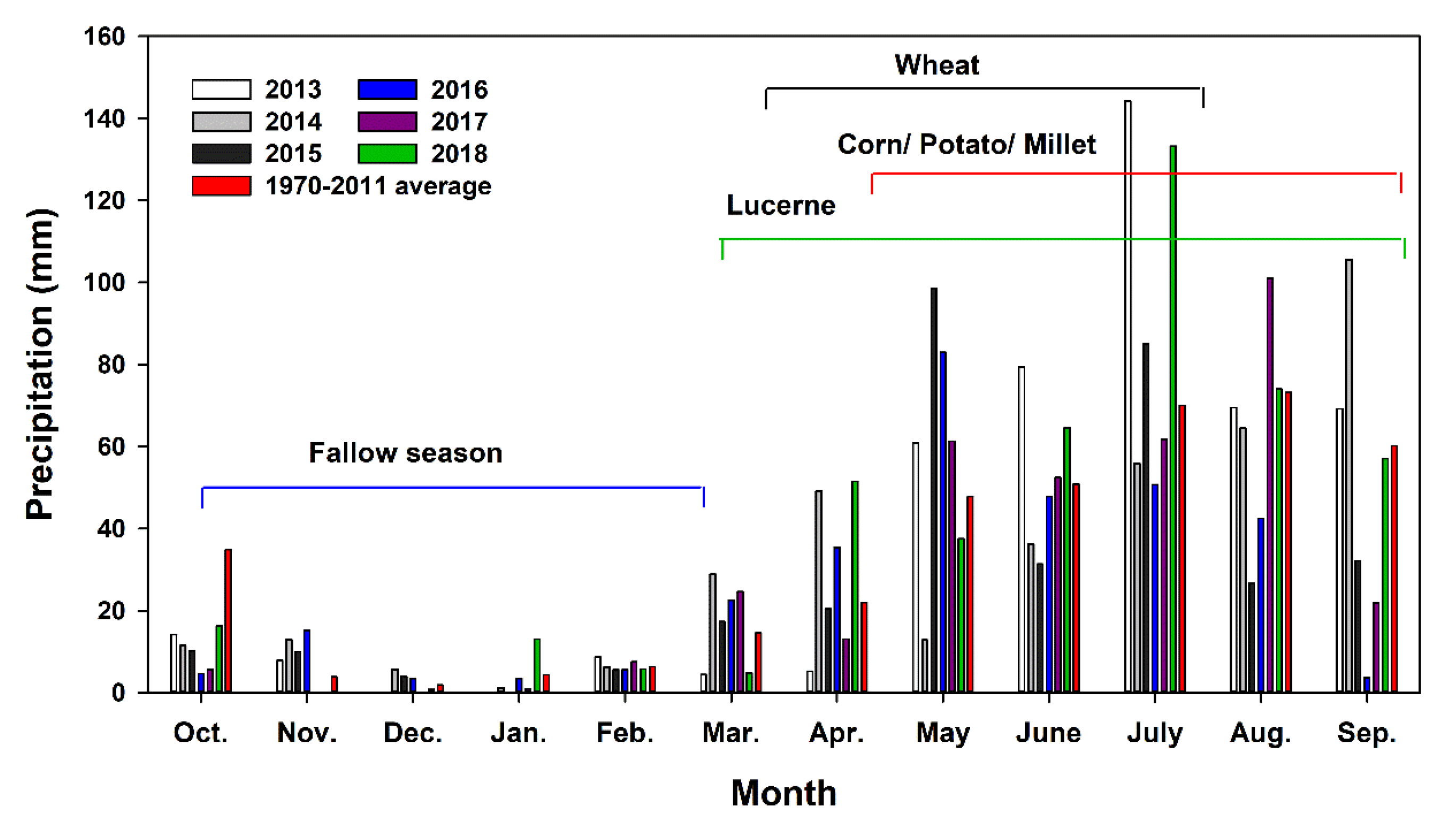
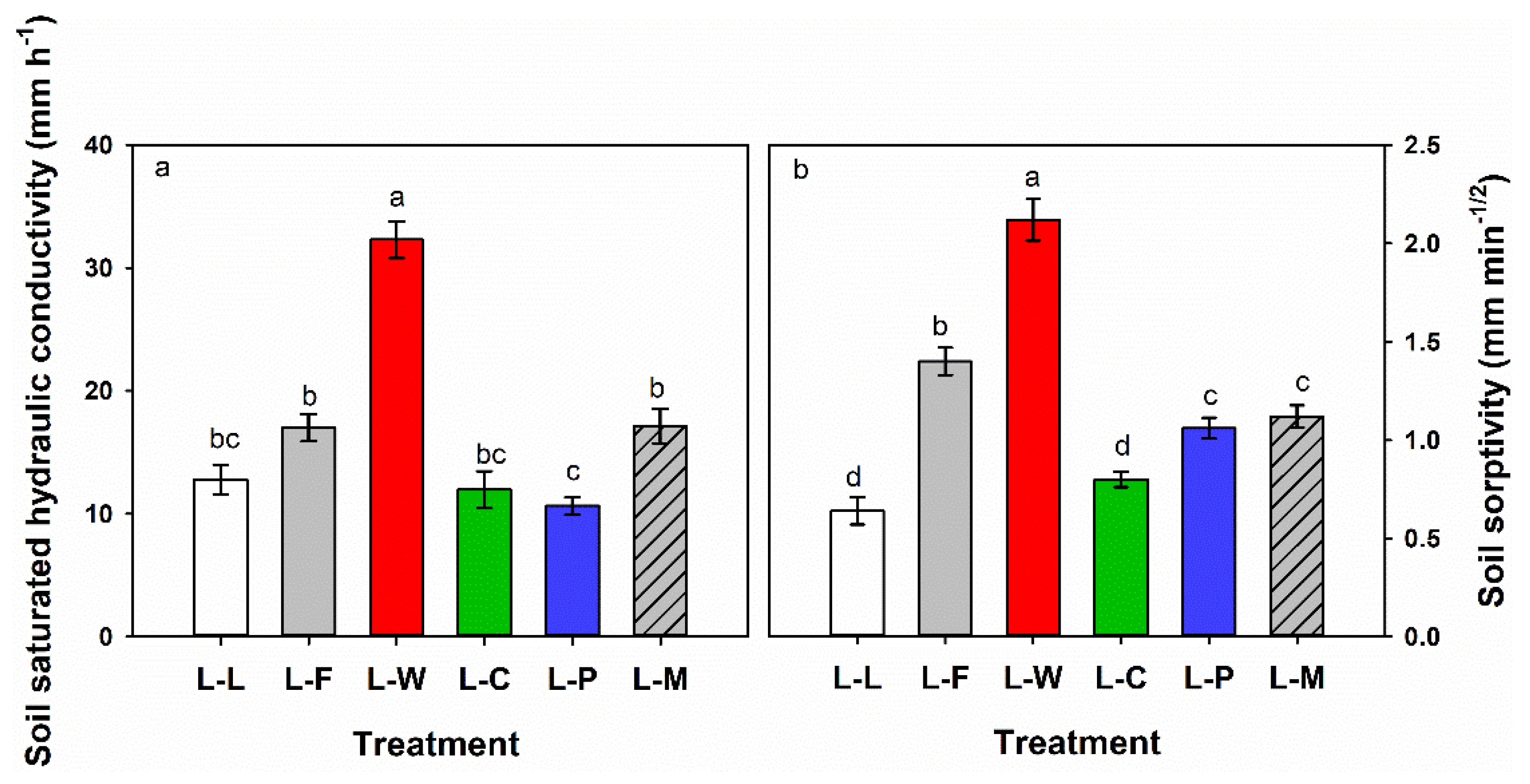
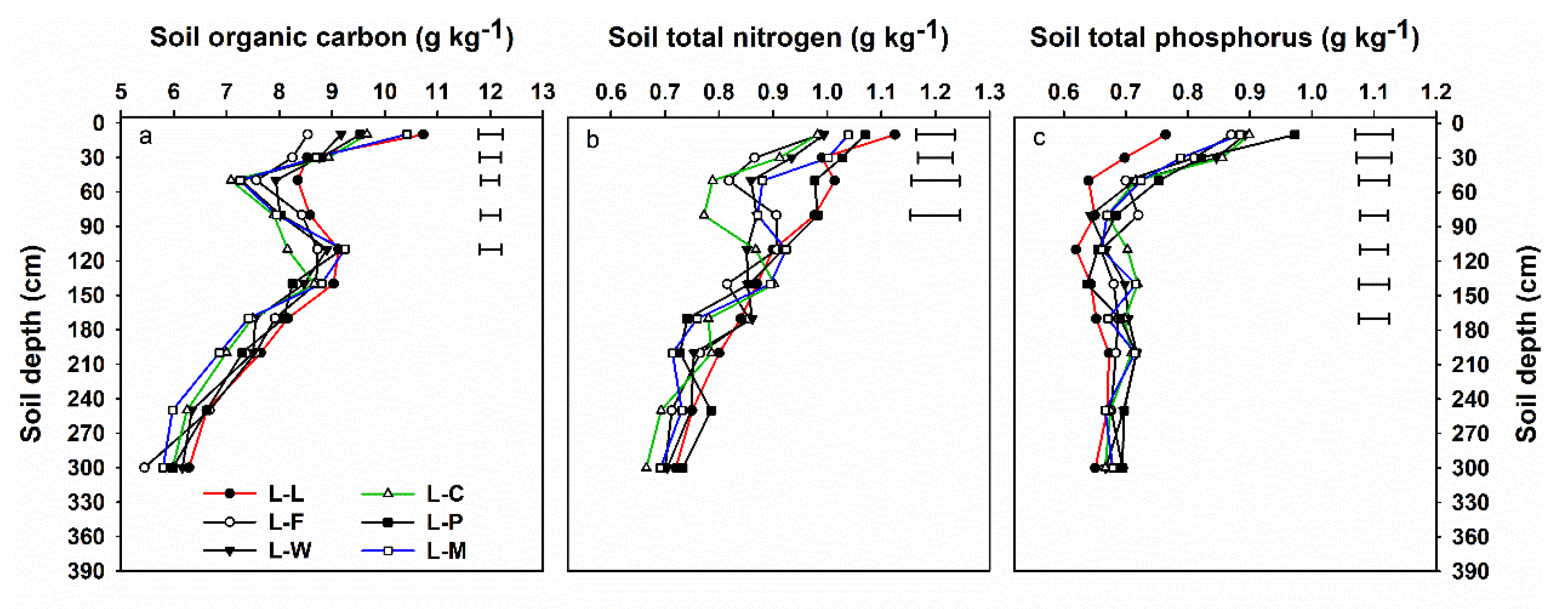
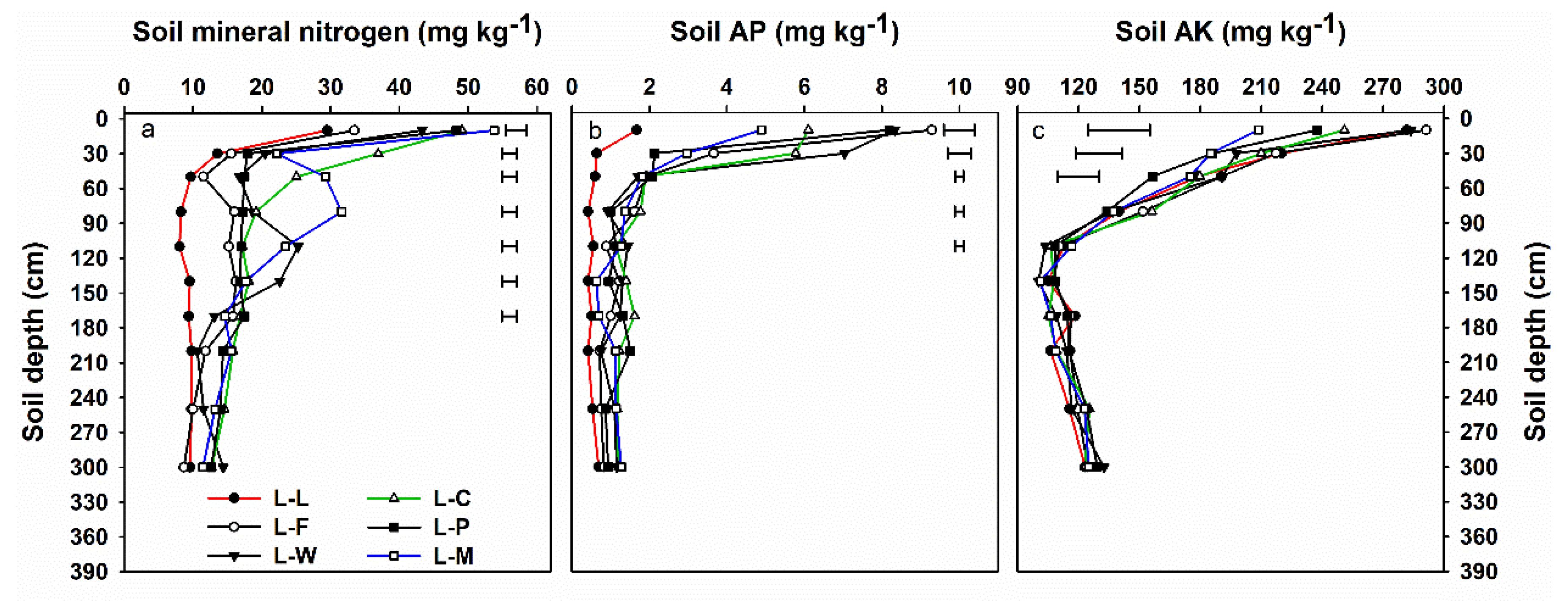
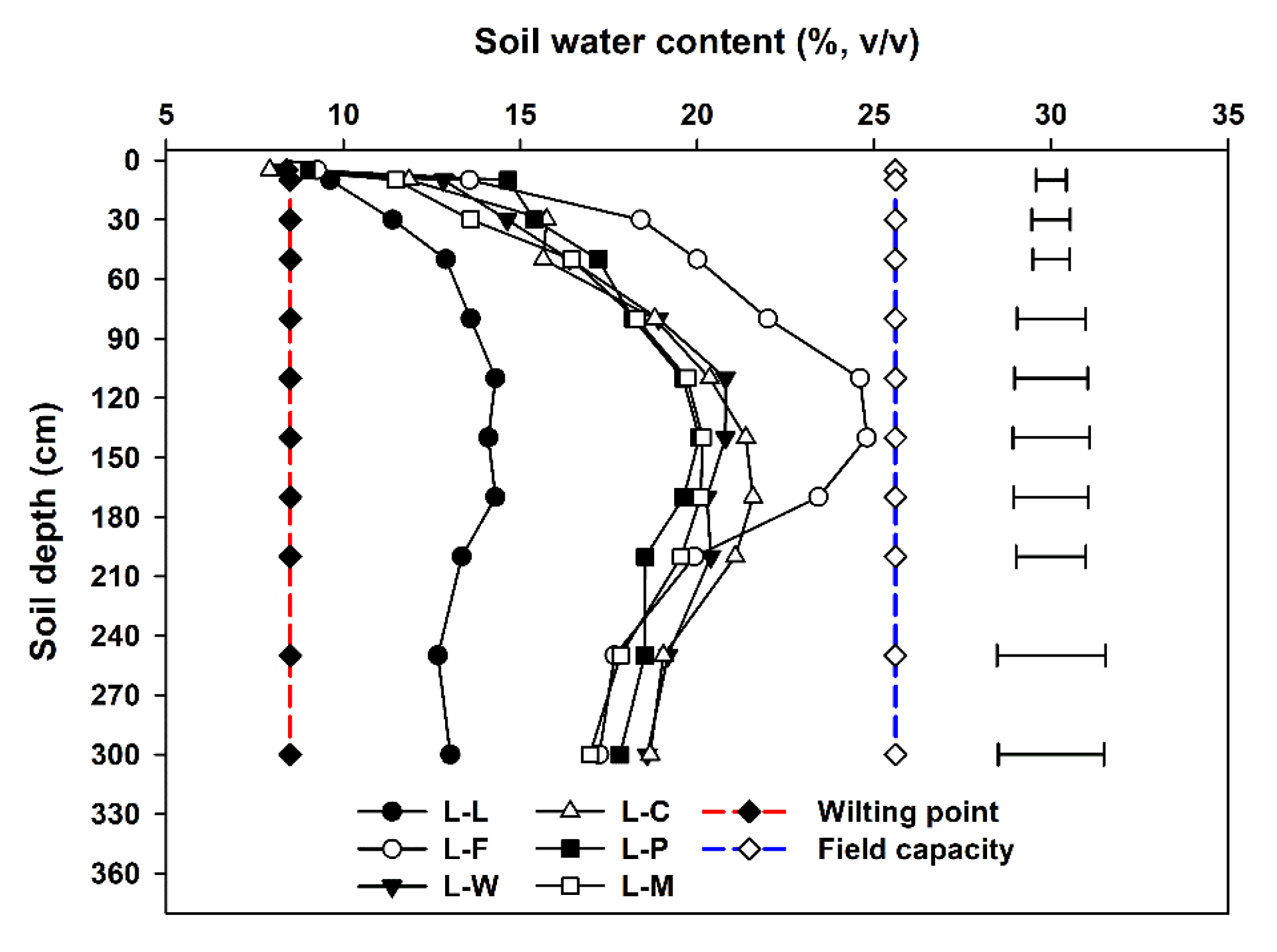

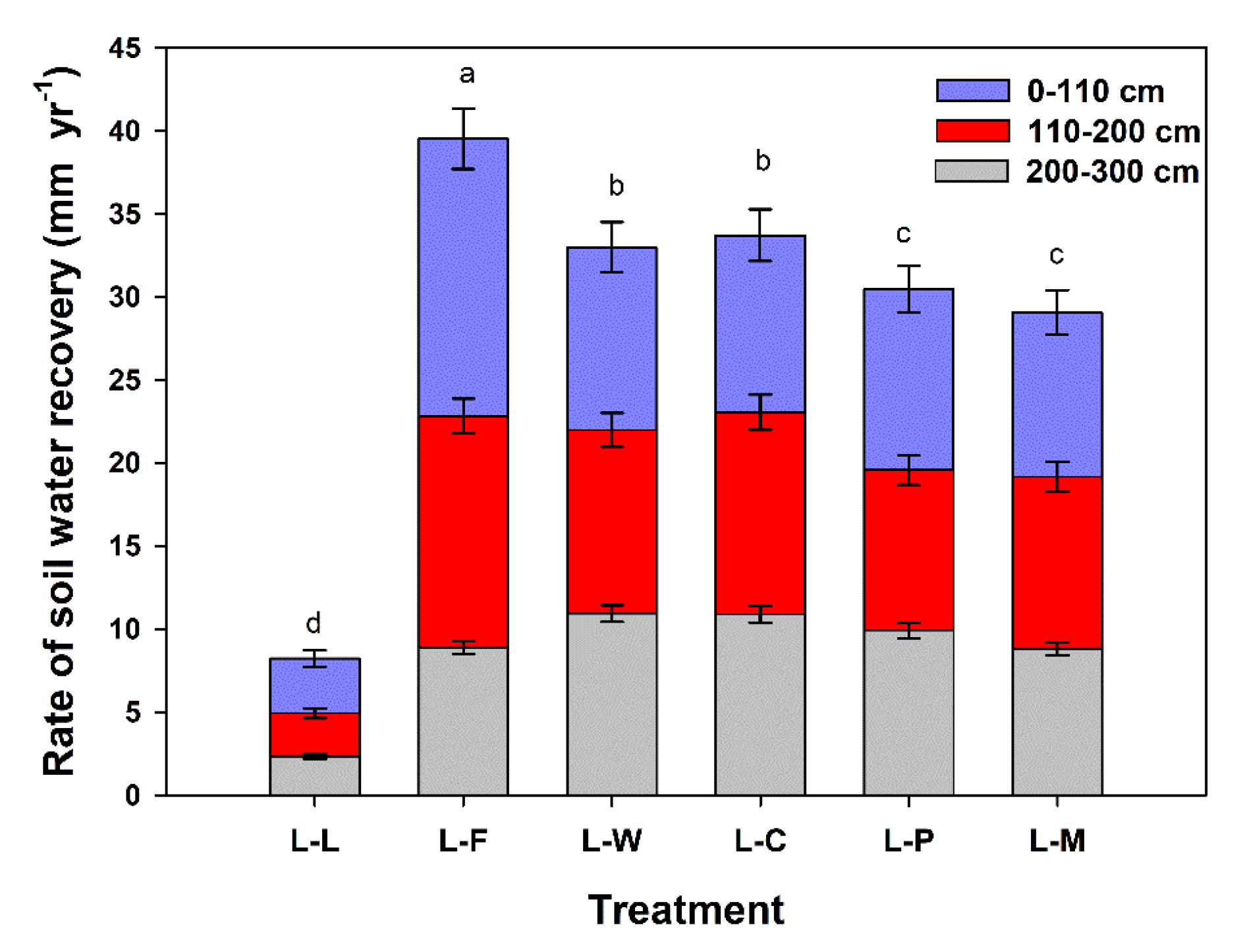
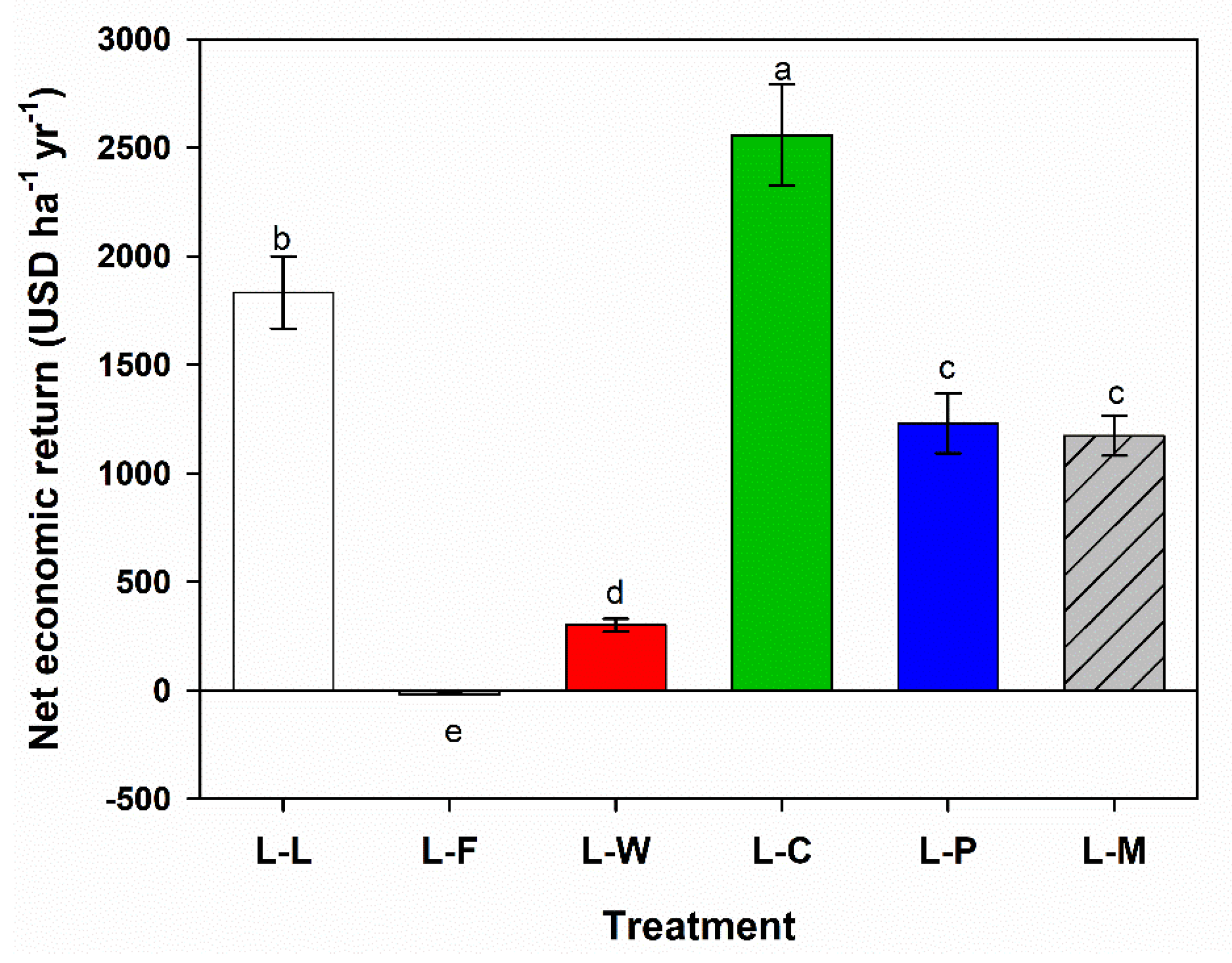
| Treatment | Description |
|---|---|
| Lucerne–lucerne (L–L) | Lucerne was sown in April 2003 and grown continuously until 2018. |
| Lucerne–fallow (L–F) | Lucerne was sown in April 2003 and plowed in March 2012, followed by bare fallow from 2012 to 2018. |
| Lucerne–wheat (L–W) | Lucerne was sown in April 2003 and plowed in March 2012, followed by fallow until March 2013, and then spring wheat was grown from 2013 to 2018. |
| Lucerne–corn (L–C) | Lucerne was sown in April 2003 and plowed in March 2012, followed by fallow until March 2013, and then maize was grown in a plastic film fully mulched ridge–furrow system from 2013 to 2018. |
| Lucerne–potato (L–P) | Lucerne was sown in April 2003 and plowed in March 2012, and then potato was grown from 2012 to 2018. |
| Lucerne–millet (L–M) | Lucerne was sown in April 2003 and plowed in March 2012, and then millet was grown from 2012 to 2018. |
| Year | Annual Rainfall (mm) | DI for Annual Rainfall | Soil Water Condition for Annual Rainfall * |
|---|---|---|---|
| 2013 | 471 | 1.20 | wet |
| 2014 | 384 | −0.09 | normal |
| 2015 | 340 | −0.73 | dry |
| 2016 | 300 | −1.32 | dry |
| 2017 | 361 | −0.42 | normal |
| 2018 | 445 | 0.80 | wet |
| Mean (1970–2011) | 390 | – | – |
| Treatment * | Soil Bulk Density (g cm−3) | Soil Total Porosity (%) | ||||
|---|---|---|---|---|---|---|
| 0–10 cm | 10–30 cm | 30–50 cm | 0–10 cm | 10–30 cm | 30–50 cm | |
| L–L | 1.45 a # | 1.60 a | 1.54 a | 45.2 c | 39.7 b | 42.1 c |
| L–F | 1.36 bc | 1.47 b | 1.44 bc | 48.7 ab | 44.7 a | 45.5 ab |
| L–W | 1.37 bc | 1.38 b | 1.48 ab | 48.4 ab | 47.8 a | 44.3 bc |
| L–C | 1.41 ab | 1.42 b | 1.46 ab | 46.8 bc | 46.4 a | 44.8 bc |
| L–P | 1.37 bc | 1.34 b | 1.44 bc | 48.5 ab | 49.3 a | 45.6 ab |
| L–M | 1.33 c | 1.40 b | 1.39 c | 49.9 a | 47.1 a | 47.7 a |
| Treatment * | Soil Water Absolute Restoration Index (%) | |||
|---|---|---|---|---|
| 0–110 cm | 110–200 cm | 200–300 cm | Sum (0–300 cm) | |
| L–L | 117 c # | 117 c | 115 c | 116 c |
| L–F | 189 a | 191 a | 156 b | 179 a |
| L–W | 157 b | 173 ab | 168 a | 166 ab |
| L–C | 157 b | 180 ab | 168 a | 167 ab |
| L–P | 158 b | 163 b | 162 ab | 161 ab |
| L–M | 153 b | 168 b | 155 b | 158 b |
Publisher’s Note: MDPI stays neutral with regard to jurisdictional claims in published maps and institutional affiliations. |
© 2022 by the authors. Licensee MDPI, Basel, Switzerland. This article is an open access article distributed under the terms and conditions of the Creative Commons Attribution (CC BY) license (https://creativecommons.org/licenses/by/4.0/).
Share and Cite
Wang, L.; Luo, Z.; Li, L.; Xie, J.; Fudjoe, S.K.; Zechariah, E. Exploring Optimal Cropping System to Improve the Water Use Efficiency and Soil Water Restoration after Lucerne-to-Crop Conversion in the Semiarid Environment. Agronomy 2022, 12, 1905. https://doi.org/10.3390/agronomy12081905
Wang L, Luo Z, Li L, Xie J, Fudjoe SK, Zechariah E. Exploring Optimal Cropping System to Improve the Water Use Efficiency and Soil Water Restoration after Lucerne-to-Crop Conversion in the Semiarid Environment. Agronomy. 2022; 12(8):1905. https://doi.org/10.3390/agronomy12081905
Chicago/Turabian StyleWang, Linlin, Zhuzhu Luo, Lingling Li, Junhong Xie, Setor Kwami Fudjoe, and Effah Zechariah. 2022. "Exploring Optimal Cropping System to Improve the Water Use Efficiency and Soil Water Restoration after Lucerne-to-Crop Conversion in the Semiarid Environment" Agronomy 12, no. 8: 1905. https://doi.org/10.3390/agronomy12081905






